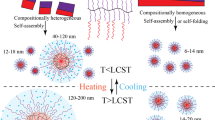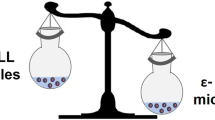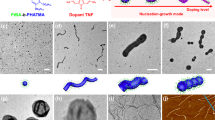Abstract
We have formulated the mixing Gibbs energy density for the micelle phase of an amphiphilic block copolymer solution using mean-field lattice theory. We have found a transition between the micellization and the liquid–liquid phase separation in this solution by comparing the mixing Gibbs energy density for the micelle phase with that for the homogeneous phase. Micellization is preferred over the liquid–liquid phase separation not only at a higher amphiphilicity of the block copolymer chain but also at a higher degree of polymerization of the copolymer.
Similar content being viewed by others
Log in or create a free account to read this content
Gain free access to this article, as well as selected content from this journal and more on nature.com
or
References
Topp, M. D. C., Dijkstra, P. J., Talsma, H. & Feijen, J. Thermosensitive micelle-forming block copolymers of poly(ethylene glycol) and poly(N-isopropylacrylamide). Macromolecules 30, 8518–8520 (1997).
Zhu, P. W. & Napper, D. H. Effect of heating rate on nanoparticle formation of poly(N-isopropylacrylamide)-poly(ethylene glycol) block copolymer microgels. Langmuir 16, 8543–8545 (2000).
Neradovic, D., Soga, O., Van Nostrum, C. F. & Hennink, W. E. The effect of the processing and formulation parameters on the size of nanoparticles based on blockcopolymers of poly(ethylene glycol) and poly(N-isopropylacrylamide) with and without hydrolytically sensitive groups. Biomaterials 25, 2409–2418 (2004).
Sugihara, S., Kanaoka, S. & Aoshima, S. Double thermosensitive diblock copolymers of vinyl ethers with pendant oxyethylene groups: unique physical gelation. Macromolecules 38, 1919–1927 (2005).
Zhang, W., Shi, L., Wu, K. & An, Y. Thermoresponsive micellization of poly(ethylene glycol)-b-poly(N-isopropylacrylamide) in water. Macromolecules 38, 5743–5747 (2005).
Yusa, S., Yamago, S., Sugahara, M., Morikawa, S., Yamamoto, T. & Morishima, Y. Thermo-responsive diblock copolymers of poly(N-isopropylacrylamide) and poly(N-vinyl-2-pyrroridone) synthesized via organotellurium-mediated controlled radical polymerization (TERP). Macromolecules 40, 5907–5915 (2007).
Annaka, M., Morishita, K. & Okabe, S. Electrostatic self-assembly of neutral and polyelectrolyte block copolymers and oppositely charged surfactant. J. Phys. Chem. B 111, 11700–11707 (2007).
Kjøniksen, A.-L., Zhu, K., Pamies, R. & Nystrom, B. Temperature-induced formation and contraction of micelle-like aggregates in aqueous solutions of thermoresponsive short-chain copolymers. J. Phys. Chem. B 112, 3294–3299 (2008).
Mendrek, S., Mendrek, A., Adler, H.-J., Dworak, A. & Kuckling, D. Temperature-sensitive behaviour of poly(glycidol)-b-poly(N-isopropylacrylamide) block copolymers. Colloid Polym. Sci. 288, 777–786 (2010).
de Graaf, A. J., Boere, K. W. M., Kemmink, J., Fokkink, R. G., van Nostrum, C. F., Rijkers, D. T. S., van der Gucht, J., Wienk, H., Baldus, M., Mastrobattista, E., Vermonden, T. & Hennink, W. E. Looped structure of flowerlike micelles revealed by 1H NMR relaxometry and light scattering. Langmuir 27, 9843–9848 (2011).
Mori, H., Ebina, Y., Kambara, R. & Nakabayashi, K. Temperature-responsive self-assembly of star block copolymers with poly(ionic liquid) segments. Polym. J. 44, 550–560 (2012).
Alimada, B., Yamamoto, S. & Moriya, O. Synthesis of thermo- and photoresponsive polysilsesquioxane containing tetraethylene glycol chains and an azobenzene group. Polym. J. 46, 243–249 (2014).
Ma, X., Usui, R., Kitazawa, Y., Kokubo, H. & Watanabe, M. Temperature and light-induced self-assembly changes of a tetra-arm diblock copolymer in an ionic liquid. Polym. J. 47, 739–746 (2015).
Takahashi, R., Sato, T., Terao, K., Qiu, X.-P. & Winnik, F. M. Self-association of a thermosensitive poly(2-oxazoline) block copolymer in aqueous solution. Macromolecules 45, 6111–6119 (2012).
Sato, T., Tanaka, K., Toyokura, A., Mori, R., Takahashi, R., Terao, K. & Yusa, S. Self-association of a thermosensitive amphiphilic block copolymer poly(N-isopropylacrylamide)-b-poly(N-vinyl-2-pyrrolidone) in aqueous solution upon heating. Macromolecules 46, 226–235 (2013).
Takahashi, R., Qiu, X.-P., Xue, N., Sato, T., Terao, K. & Winnik, F. M. Self-association of the thermosensitive block copolymer poly(2-isopropyl-2-oxazoline)-b-poly(N-isopropylacrylamide) in water−methanol mixtures. Macromolecules 47, 6900–6910 (2014).
Kondo, M., Takahashi, R., Qiu, X.-P., Winnik, F. M., Terao, K. & Sato, T. Small-angle X-ray scattering from the concentrated phase in a phase-separated block-copolymer solution. Polym. J. (in press)
Hong, K. M. & Noolandi, J. Theory of phase equilibria in systems containing block copolymers. Macromolecules 16, 1083–1093 (1983).
Fredrickson, G. H. & Leibler, L. Theory of block copolymer solutions: nonselective good solvents. Macromolecules 22, 1238–1250 (1989).
Birshtein, T. M. & Zhulina, E. B. Scaling theory of supermolecular structures in block copolymer-solvent systems:1. Model of micellar structures. Polymer 30, 170–177 (1989).
Leibler, L., Orland, H. & Wheeler, J. C. Theory of critical micelle concentration for solutions of block copolymers. J. Chem. Phys. 79, 3550–3557 (1983).
Flory, P. J. Principles of Polymer Chemistry, (Cornell Univ. Press, Ithaca, New York, USA, 1953).
Förster, S., Zisenis, M., Wenz, E. & Antonietti, M. Micellization of strongly segregated block copolymers. J. Chem. Phys. 104, 9956–9970 (1996).
Takahashi, R., Sato, T., Terao, K. & Yusa, S. Intermolecular interactions and self-assembly in aqueous solution of a mixture of anionic−neutral and cationic−neutral block copolymers. Macromolecules 48, 7222–7229 (2015).
Acknowledgements
This study was supported by Grant-in-Aid for JSPS Research Fellow (Grant No. 16J00359; RT).
Author information
Authors and Affiliations
Corresponding author
Ethics declarations
Competing interests
The authors declare no conflict of interest.
Additional information
Supplementary Information accompanies the paper on Polymer Journal website
Supplementary information
Rights and permissions
About this article
Cite this article
Sato, T., Takahashi, R. Competition between the micellization and the liquid–liquid phase separation in amphiphilic block copolymer solutions. Polym J 49, 273–277 (2017). https://doi.org/10.1038/pj.2016.110
Received:
Revised:
Accepted:
Published:
Issue date:
DOI: https://doi.org/10.1038/pj.2016.110
This article is cited by
-
Stimuli-responsive hydrogels for skin wound healing and regeneration
Emergent Materials (2024)
-
Liquid–liquid phase separation during amphiphilic self-assembly
Nature Chemistry (2019)
-
The molecular Lego movie
Nature Chemistry (2019)
-
Small-angle X-ray scattering from the concentrated bulk phase separated from an amphiphilic block-copolymer solution
Polymer Journal (2017)



